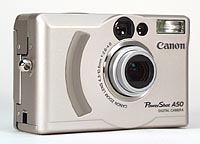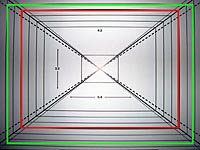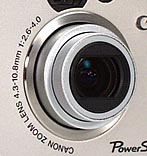 |

 |
* |
1280x960 resolution |
|
* |
Compact, rugged case |
|
* |
2.5x Optical Zoom Lens |
|
* |
Great low-light ability (up
to ISO400) |
|
* |
Panorama support, including
2x2 matrix! |
|
|

Canon PowerShot A50 Review Index:
Viewfinder
 Like most digicams these days,
the PowerShot A50 includes both optical and LCD viewfinders.
The optical viewfinder is a bit "looser" than most,
showing only 80% of the final picture area at the wide-angle
end of the zoom's range, and 78% at the telephoto end. The LCD
viewfinder also crops slightly, showing about 95% of the final
image at all times. We also found the optical viewfinder to have
a slightly low eyepoint and no dioptric correction, making it
a bit awkward for eyeglass wearers. (Only a bit though: We had
no real problems using the optical viewfinder with eyeglasses,
but would have felt a little more comfortable if we hadn't had
to actually touch our eyeglasses to the viewfinder bezel.) The
image at right shows the approximate areas of coverage provided
by the optical (red lines) and LCD (green lines) viewfinders,
relative to the final image area. Like most digicams these days,
the PowerShot A50 includes both optical and LCD viewfinders.
The optical viewfinder is a bit "looser" than most,
showing only 80% of the final picture area at the wide-angle
end of the zoom's range, and 78% at the telephoto end. The LCD
viewfinder also crops slightly, showing about 95% of the final
image at all times. We also found the optical viewfinder to have
a slightly low eyepoint and no dioptric correction, making it
a bit awkward for eyeglass wearers. (Only a bit though: We had
no real problems using the optical viewfinder with eyeglasses,
but would have felt a little more comfortable if we hadn't had
to actually touch our eyeglasses to the viewfinder bezel.) The
image at right shows the approximate areas of coverage provided
by the optical (red lines) and LCD (green lines) viewfinders,
relative to the final image area.
The LCD brightness can be adjusted via a menu option, but we're
happy to report that the A50 has one of the brighter and higher-resolution
LCD screens that we've tested. (Actually, the issue is less one
of brightness than contrast: The A50's screen seems to wash out
less in bright light, not so much because the white areas are
brighter than those on other cameras' screens, but because there's
less glare reflected from the dark areas.) As noted earlier,
Canon doesn't give a specification for the number of pixels displayed
by the A50's LCD, but it's clearly (no pun intended) one of the
sharper units we've seen. Besides its brightness and sharpness,
the A50's LCD also has one of the highest refresh rates we've
observed: Even fairly fast-moving objects stay sharp and in-focus,
making the camera idea for pictures where there's a lot of action
going on. (The ideal camera for the "soccer mom?")
Optics
 The PowerShot A50's lens is a true optical
zoom, with a focal length range equivalent to that of a 28-70mm
lens on a 35mm film camera. This is a bit wider than the lenses
on most digicams, meaning that it won't get you quite as close
to your subjects as some other cameras, but will do a better
job of fitting everything into the frame in tight quarters. (Combined
with an excellent low-light capability, this suggests that the
A50 would be an ideal choice if a lot of your shooting is done
indoors.) As part of its excellent low-light performance, the
lens is a fairly "fast" one, having a maximum aperture
of f/2.6 at wide-angle, and f/4.0 in telephoto mode. The lens
is an autofocus design, with a normal focusing range of 20 inches
(51 cm) to infinity, and a range in the separate macro mode of
6.7 to 20 inches (17 to 51 cm). The zoom position is controlled
by a rocker control in the upper left-hand corner of the camera's
rear panel. The PowerShot A50's lens is a true optical
zoom, with a focal length range equivalent to that of a 28-70mm
lens on a 35mm film camera. This is a bit wider than the lenses
on most digicams, meaning that it won't get you quite as close
to your subjects as some other cameras, but will do a better
job of fitting everything into the frame in tight quarters. (Combined
with an excellent low-light capability, this suggests that the
A50 would be an ideal choice if a lot of your shooting is done
indoors.) As part of its excellent low-light performance, the
lens is a fairly "fast" one, having a maximum aperture
of f/2.6 at wide-angle, and f/4.0 in telephoto mode. The lens
is an autofocus design, with a normal focusing range of 20 inches
(51 cm) to infinity, and a range in the separate macro mode of
6.7 to 20 inches (17 to 51 cm). The zoom position is controlled
by a rocker control in the upper left-hand corner of the camera's
rear panel. 
The PowerShot A50's zoom control achieves a good balance between
speed and "settability", apparently allowing the focal
length to be set continuously anywhere within the lens' range.
We haven't been tracking this, but some cameras afford less-smooth
control over lens focal length, seeming to prefer a relative
small number of discrete steps, rather than a continuous range.
The A50's lens seems to allow a continuous range of settings,
but does have a slight "backlash" at the wide and telephoto
ends, depending on the direction you're zooming in: If you're
moving from telephoto toward wide-angle focal lengths, the lens
will "back up" a tiny amount after you've released
the zoom control, while the lens is in the telephoto half of
its range. (Once you get into wide-angle territory, this behavior
disappears.) Likewise, as you move from wide to telephoto focal
lengths, there's a similar "backlash" while you're
in the wide-angle range. Overall, this effect is much less severe
than we've seen in some cameras, but it does make (very) precise
framing with the zoom a bit more difficult. We don't see this
as a huge problem though, particularly when adjusting your shooting
position by as little as a foot or so will compensate for any
hesitation in the zoom mechanism.
In keeping with Canon's long experience and reputation for optical
quality in the film camera world, the lens on the A50 appears
to be of very high quality. Chromatic aberration (seen as a color
"fringing" on high-contrast objects near the edges
of the field of view) is virtually non-existent. Geometric distortion
is also fairly low, ranging from 1.1% barrel distortion at the
wide-angle end of the lens' range to no measurable distortion
(either barrel or pincushion) at the telephoto end. (While we
only measure geometric distortion at the end of the lenses' range,
an informal test seemed to show that the barrel distortion vanished
fairly rapidly as we moved away from the widest-angle setting
of the lens.)
Autofocus-Assist Light
We gave this feature it's own heading, because low-light focusing
has become such an issue with digicams lately. Cameras with through-the-lens
contrast-detect autofocus systems (which generally produce the
most accurate results with good lighting) have a hard time finding
the optimum focus when the scene lighting is low. A very few
cameras (the PowerShot A50 being one) provide a focus-assist
light when there's not enough ambient light available to focus
with. In the case of the A50, this light is provided by a small
incandescent bulb internal to the camera, which casts a pattern
of light and dark vertical bars onto the subject when the light
level is less than ~EV 10 or 11. This lets the camera focus accurately
in complete darkness, a very nice feature. (The one possible
downside is that it would prevent truly candid shots under low
light. For our part though, we'll take well-focused non-candids
any day!) This autofocus-assist worked very well, as even shots
taken in the very darkest of settings were perfectly focused.
|
 |